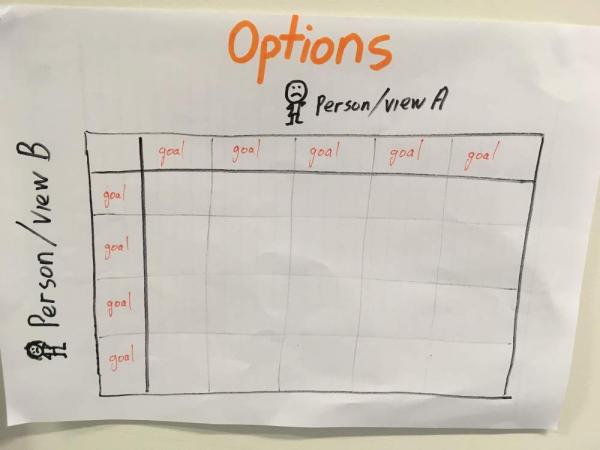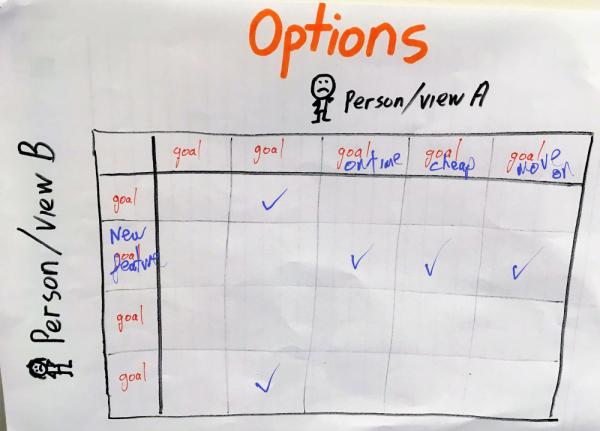Using the options generator for conflict resolution
The options generator is a tool that someone taught me a long time ago, to be used as an innovation idea generator.
Basically, you are supposed to find two people and have them share some things that they are good at, then you ask them to identify how they can combine their strengths to come up with a new business or idea to work together on.
Most often though, I have used it for conflict resolution – when two people or tribes have different goals or needs. In this context, it seeks to shift people from confrontation to collaboration. Where this fails, it is at least useful for identifying the real point of conflict among all the unnecessary noise.
Using the options generator
Firstly, find two people with differing opinions, or differing perspectives and have each explain what they want/believe. For this example, I will assume that a project is due to go live, but there are unresolved problems and an important feature that will miss the release.
Person A wants to go live on time because there are contractual implications and upset stakeholders if we miss the promised release date. Person B wants to include an additional feature and resolve all the issues so that the release will be awesome … but late.
But the issue is a little more complex than simply go live now versus go late. So we get people to be more specific with what they are trying to achieve. We ask why person A wants to go live on time and why person B wants to add more stuff.
We find that person A really wants a few different things:
- To make the client happy
- To keep our commitments (the published release date)
- To avoid spending more money
- To free the team up for the next adventure
- To test what we have in production before we build more
Person B also has some different goals:
- To meet our quality commitments
- To make money from the new feature as early as possible
- To keep our clients happy
- To avoid repair work and warranty issues after the release
- To be proud of what we do
This is complex enough to result in several arguments, so we draw up an options generator:

This is a grid with one person’s goals along the top and the other person’s goals along the left. It is useful when both people have 2-5 different goals or needs. The only rules here are that each person must be able to explain what they mean and the language must be positive. By “positive” I mean simply that we cannot use the words not, no etc. It is hard to use the generator when the sentences are negative or vague wording, so we just reword it.
Once we have added the goals at the top and down the left then we move through the different goals and see if there is any clash.
For example, person A wants to make our client happy. They do not have to justify this, but we need to tick a box where there might be a clash. So, for example, there is no clash between “make the client happy” and “meet quality requirements.” So we don’t discuss these, we simply move on.
But it turns out that there are some clashes around the “make money from the new feature” and both the goals of “meet our time commitments” and “avoid spending more money” and “free the team up.” So we highlight these on in the appropriate boxes in our grid.

This step was important because we want to avoid jumping from argument to argument. So now we can simply focus on those points where we need some kind of resolution.
You might notice that my wording changes between what I originally said the goals were and what was written in the generator. This is OK and in fact, often people reword, add or remove goals in order to clarify what they mean.
Next, we need to resolve the conflicts one at a time. So we stop at each box with a tick in it and have an argument (er – fruitful, collaborative discussing involving some different views – or fight, battle, negotiation. The wording doesn’t matter).
There is an important rule here though. We have to use the word “and” rather than “or”. So, for example, we ask “how can we make money from the new feature AND deliver something on time.”
It may seem impossible, but the word “and” often uncovers ideas that are not expected. We call these options and we write down both smart and dumb ones to see if any are worth pursuing.
For example, we could “skip testing” which would be dumb. We could work weekends, we could include only part of the feature, we could turn off some of the other features in order to get there.
Once we have some options we might agree that one or more are potentially worth exploring. Then we move onto the next clash and repeat the process.
Often the same options appear multiple times and we then realise that they are worth exploring. Often we also find that there is an acceptable solution to every one of the clashes, but that we need to do something different.
This is the key benefit of the options generator – we cut to the chase and focus only on the real points of difference and we openly explore multiple options to these before moving on.
But what if there is no good option? Well, there are at least two – deliver on time without the feature or deliver the feature, no matter what it takes. If that is really the outcome then we can escalate the conflict or move onto negotiation, confident that we have explored all the other options we could think of. This happens less often that you would expect (only about 5-10% of the time with seemingly difficult conflicts). But even when we are at this point I find that clarity around our positions and our justification makes the negotiation far more productive than when we are wasting time on misunderstanding or minor points of difference.
Once we have a set of options then we prioritise the ones we will act on and then put them into an action plan.
That’s it – a simple tool that has worked for me many times. Hope it works for you too.
Posted by James King
Copyright © James King
Thank you!
Your details have been submitted and we will be in touch.